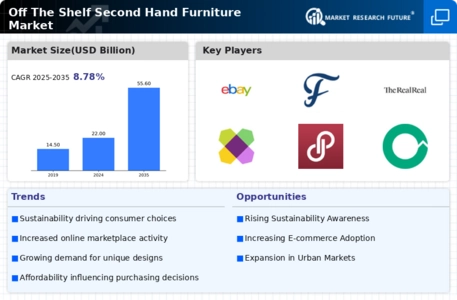The Off The Shelf Second Hand Furniture Market is currently characterized by a dynamic competitive landscape, driven by increasing consumer interest in sustainability and cost-effective solutions. Key players such as IKEA (SE), Goodwill Industries (US), and Facebook Marketplace (US) are strategically positioned to leverage these trends. IKEA (SE) continues to innovate its product offerings, focusing on eco-friendly materials and circular economy principles, while Goodwill Industries (US) emphasizes community engagement and social responsibility through its retail operations. Facebook Marketplace (US) capitalizes on its vast user base to facilitate peer-to-peer transactions, enhancing accessibility and convenience for consumers. Collectively, these strategies not only enhance brand loyalty but also shape a competitive environment that prioritizes sustainability and community involvement.
In terms of business tactics, companies are increasingly localizing their supply chains and optimizing logistics to reduce costs and improve service delivery. The market appears moderately fragmented, with a mix of large organizations and smaller, niche players. This structure allows for diverse offerings, catering to various consumer preferences. The collective influence of these key players fosters a competitive atmosphere where innovation and customer engagement are paramount.
In September 2025, IKEA (SE) announced the launch of a new initiative aimed at expanding its second-hand furniture program, which encourages customers to return used items for store credit. This move not only enhances IKEA's sustainability credentials but also strengthens customer loyalty by promoting a circular economy. The initiative is expected to drive foot traffic to stores while simultaneously addressing the growing demand for sustainable products.
In August 2025, Goodwill Industries (US) unveiled a partnership with a local tech startup to enhance its online sales platform. This collaboration aims to streamline the purchasing process and improve the user experience for online shoppers. By integrating advanced technology, Goodwill Industries (US) is likely to attract a younger demographic, thereby expanding its market reach and reinforcing its position as a leader in the second-hand furniture sector.
In July 2025, Facebook Marketplace (US) introduced new features designed to enhance buyer-seller interactions, including improved search filters and a rating system for transactions. This strategic enhancement is indicative of Facebook's commitment to fostering a safe and efficient marketplace for second-hand goods. By prioritizing user experience, Facebook Marketplace (US) is poised to solidify its competitive edge in the rapidly evolving digital landscape.
As of October 2025, current trends in the Off The Shelf Second Hand Furniture Market indicate a pronounced shift towards digitalization, sustainability, and the integration of artificial intelligence in customer interactions. Strategic alliances among key players are increasingly shaping the competitive landscape, fostering innovation and enhancing service delivery. Looking ahead, it appears that competitive differentiation will evolve from traditional price-based competition to a focus on technological advancements, supply chain reliability, and innovative product offerings, thereby redefining consumer expectations in the second-hand furniture market.

















Leave a Comment